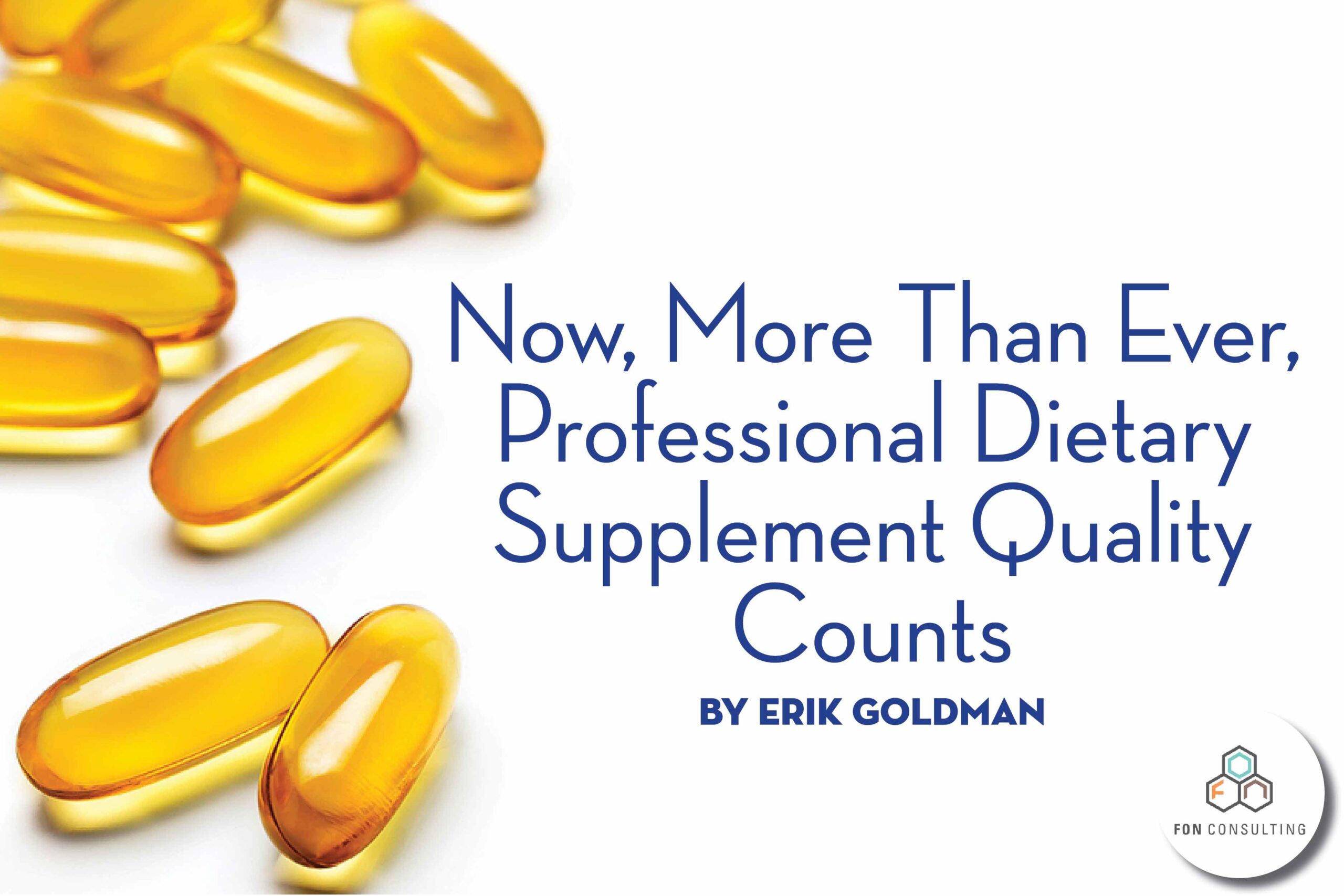Now, More Than Ever, Professional Dietary Supplement Quality Counts
By Erik Goldman

Practitioner brands must deal with an absence of consensus on the criteria that define optimal quality.
“Be prepared to compete on the battlefield of quality,” said nutrition industry consultant Michael D. Levin.
Speaking at Holistic Primary Care’s 2017 Practitioner Channel Forum, Mr. Levin said he expects, “increased demand for transparency in all channels, but especially in the practitioner channel.”
The quality imperative was a recurring theme throughout the Forum, which drew executives from major practitioner-focused brands and ingredient suppliers, as well as other industry stakeholders.
In a talk titled “Reaching Consensus on Evidence-Based Quality,” Mr. Levin contended that practitioner brands that want to thrive in the future need to “inspire trust, and drip credibility” to justify their generally higher price tags.
Amazon’s new Elements supplement line, launched this Spring, is entirely focused on a quality proposition that boasts transparency, traceability, purity, and freedom from toxins. The online retail behemoth offers its products at a fraction of the price of typical practitioner-dispensed lines.
Amazon uses a contract manufacturer to produce the Elements line, and it is far from transparent about the specifics of its quality testing methodologies. But for that matter, so are many other brands both within and outside the practitioner space.
The point is, the competition just heated up, big-time. Channel players must prepare to help doctors answer patients who say, “Look Doc, I can get this same stuff, cheaper, with a 94 quality score, and proven freedom from pesticides at half the cost! Why should I use the brand you recommend?”
Toward Evidence-Based Quality
The state of supplement regulation and quality assurance is far more evolved than the industry’s loudest critics choose to believe. But it is far less thorough and consistent than advocates care to admit. There is clearly much room for improvement.
The FDA defines “quality” in its current Good Manufacturing Practices guidance as follows: “the dietary supplement consistently meets the established specifications for identity, purity, strength, and composition, and limits on contaminants, and has been manufactured, packaged, labeled, and held under conditions to prevent adulteration.”
Enjoying this article? Subscribe and get our latest, delivered straight to your inbox.
But Mr. Levin, the principal at Health Business Strategies, LLC, is quick to point out that, “Compliance with cGMPs does not ensure superior quality. It just doesn’t. You can have a GMP-compliant product meeting all the specs and still have problems” with adulterants and contaminants.
The big issue—one that supplement critics rightfully underscore—is that FDA allows each company to establish its own specifications. “It’s a fox in the henhouse sort of thing, and it’s one of the biggest flaws in the final rules.”
The guidelines state that a company “must establish limits on those types of contaminants that may adulterate or may lead to adulteration of the finished batch of the dietary supplement.” But between the “must” and the “may” there’s a lot of room for interpretation.
Mr. Levin worked closely with Cancer Treatment Centers of America, the nation’s largest network of cancer care hospitals that combine traditional conventional cancer care with integrative medicine and other evidence-informed therapies. While there he helped CTCA create its own product line that affiliated clinicians could trust to give to people with cancer. He also established evidence-based quality criteria that CTCA practitioners could use when vetting outside brands.
He holds there are three basic facets of quality:
- Authenticity: consistently proven ingredients using scientifically valid analytical methods fit for purpose (UAMFFP);
- Potency: The product meets label claim(s) at expiration date, based on UAMFFP;
- Purity: Consistently proven maximum freedom from reasonably anticipated chemical and biological contaminants (UAMFFP).
Beyond these core three values, the highest quality products are also designed in a way to ensure safety and efficacy in conditions of expected use, and backed by clinical evidence of safety and efficacy in actual real-world use.
Product Quality Benchmarks
Yadim Medore, founder of Pure Branding, who also spoke at the Practitioner Channel Forum, said most practitioner brands insist their products are “superior quality.” By and large, practitioners who use these products believe them.
But few brands really get down into the details when explaining their quality standards and validation methods, and few practitioners have the time or knowledge to ask the right questions.
“Some companies may believe their science or their technology differentiates them. But most people don’t really understand the technical differences. It’s a credentialing factor, but it’s not a (brand) differentiation point,” said Mr. Medore.
What Do Doctors Really Want?
Mr. Medore, who has studied practitioner engagement with supplements, said he sees two confidence tiers within the clinical space. There are clinicians who recommend or dispense supplements primarily for health maintenance or promotion of wellness, and those who recommend or dispense as part of disease management.
In the former context, the demand for trustworthiness is softer. In the latter context—where patients are fragile, disorders may be severe, and stakes are higher—the demand for trustworthiness is much greater.
As part of our 2017 Practitioner Survey, my company (Holistic Primary Care) included a question about decisive quality criteria.
We asked: “In evaluating whether to introduce a new product or brand to your patients, how important are the following factors?”
Respondents were free to check off any of the following criteria: free of heavy metals; free of artificial sweeteners; free of allergens; free of GMOs; practitioner-only status; presence of third-party seals; price; presence of expiry dates; product-specific data; U.S. only ingredients.
A total of 661 clinicians responded, representing a broad range of practitioner categories. One third were Medical Doctors.
The issue of heavy metals was by far the most decisive factor, selected by 77%. Sweeteners were second (72%), followed by allergens (61%), GMO ingredients (60%), and expiry dates (38%).
Overall, the survey indicated that practitioners do have concerns about product quality, and that toxins are foremost on their minds.
These findings echo Mr. Medore’s assertion. HPC’s respondents use supplements to treat sick people with a wide range of often-serious disorders. They want to ensure that they’re not doing any harm with the products they recommend.
Enjoying this article? Subscribe and get our latest, delivered straight to your inbox.
That said, the verbatim comments showed that most clinicians are going on blind faith that professional-only companies are doing their utmost to ensure quality and safety, and that the products are of better quality than those available in retail stores. Few have the knowledge or the time to delve into the details, and to take companies to task on quality issues.
Room for Improvement
Are these clinicians justified in putting their faith in pro-channel brands? Yes, and no, said Mr. Levin.
As part of a product safety initiative, Mr. Levin and his CTCA colleagues recently applied a standardized 75-question quality evaluation tool to 19 practitioner-focused product lines made by 12 manufacturers.
All 12 companies claimed full cGMP compliance at the time of the survey. By and large they’re producing good quality products.
However, public records showed that three had received warning letters for cGMP non-compliance; two had product recalls within the past five years; four had products that failed potency or purity testing by ConsumerLab.com; and one did not have clear product quality specifications.
Further, one company rejected by CTCA was cited by the FDA for inadequate ingredient identity testing. In another case, third-party analysis showed that a medicinal mushroom product contained illegal and potentially toxic levels of melamine.
Mr. Levin said that certain medicinal mushrooms, especially Cordyceps, are very susceptible to economic adulteration, in part because wild harvesters try to pad out the weight of their harvests with potentially toxic materials. In one case, a supplier had stuffed the Cordyceps—which are basically mummified caterpillars—with lead solder.
Melamine is another common economic adulterant originally reported in protein products. In these cases it is added intentionally (though illegally) to raise apparent protein content. In other cases, it is unintentional. In another case involving Cordyceps, illegal amounts of melamine were found in the mushroom extracts, believed to be due to the milk powder that was added to a growth medium. After that discovery, the product was removed from the U.S. market.
But melamine and heavy metals are just two of the many environmental toxins, drug residues, and other pollutants that can potentially end up in raw materials.
Though levels may be low, they have absolutely no place in practitioner channel products that will ultimately be taken by people with serious health challenges.
“There’s considerable variation in quality, in part due to regulatory limitations, but also due to willful non-compliance with cGMPs,” Mr. Levin said. “Company claims do not always stand to audit.”
Lack of adequate ingredient identity testing is consistently the number one reason for FD-483 reports by FDA against supplement makers.
Mr. Levin added that at CTCA, the application of this evidence-based quality assessment uncovered toxicity issues that otherwise would have gone undetected, and ultimately prevented cancer patients from taking some potentially toxic products.
The complete CTCA methodology and findings from CTCA’s survey will soon be published in an upcoming edition of Integrative Medicine—A Clinician’s Journal.
Building Consensus
One of the greatest quality-related challenges facing practitioner brands is the absence of consensus on the criteria that define optimal quality. While this is an industry-wide issue, it is particularly significant in the professional channel given the nature of how supplements are used clinically.
Industry leaders recognize the gaps in quality assurance, and they are taking steps to address them. The recent establishment of the Dietary Supplements Quality Collaborative is a positive sign.
This project brings together a diverse range of stakeholders, including the major supplement industry organizations (American Botanical Council, United Natural Products Alliance, Council for Responsible Nutrition, Consumer Health Products Association); leading consumer advocacy groups (AARP, National Consumers League); major medical organizations including the American Medical Association and the Academy of Nutrition & Dietetics; along with disease-specific patient advocacy groups and academic medical centers.
The goal? To “advance the quality and safety of products marketed as dietary supplements…in the interest of protecting health.”
Representatives of the Collaborative recently met with Steven Tave, the head of the FDA’s Office of Dietary Supplements, to discuss its mission, including the need to define specific standards of quality.
For our part, Holistic Primary Care has committed to educating physicians and other healthcare professionals about the realities of dietary supplement regulations, the state of quality control in the practitioner channel, and the strengths and weaknesses of QC in key supplement sectors like botanicals, omega-3s, probiotics, antioxidants, and minerals.
A special 16-page insert called “Quality Counts: A Clinician’s Guide to Supplement Quality” will run in the Fall 2017 edition of HPC, reaching 60,000 practitioners. The print insert will be followed by a series of three webinars focused on quality issues.
Our objective is to bring the clinical community up to speed, spotlight the positive work that’s being done while recognizing the gaps, and helping practitioners ask the right quality questions. Ultimately, we hope to bring the medical voice into the dialog about how to improve the quality, safety, and efficacy of the products they recommend to their patients.
This article originally appeared in Nutraceuticals World magazine with the title Now, More Than Ever, Quality Counts!





















